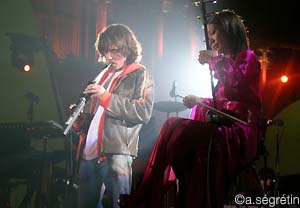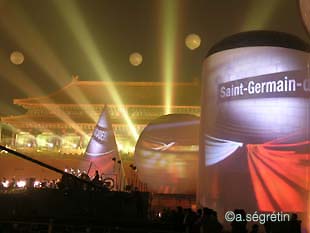Jean-Michel Jarre in Beijing
French Electro and Chinese Tradition in Dolby Surround
Beijing
11/10/2004 -

Jean-Michel Jarre's first concert appearance in China dates back to 1981. This show earned him a place in music history as the first western artist to perform in China since the Communists came to power. Jarre admits the experience was as much of a culture shock for him as it was for his audience. "I was like this Martian who'd just beamed down to Planet China," he laughs, "Everyone in the audience was sitting there goggle-eyed. They just stared and stared at me throughout the entire show."
Twenty-three years on, JMJ's mega-show in the Forbidden City caused just as great a stir. The 16,000-strong audience stood rooted to the spot, completely under the French wizard's spell, their faces wearing wrapt expressions as they struggled to take in the extraordinary spectacle unfurling before their eyes. Jarre's futuristic décor of giant cones, cylinders and inflatable spheres made a striking contrast with the ancient backdrop of the Imperial Palace built by the Ming emperors. And the contrast gained a surreal edge when images of the Paris métro and symbolic landmarks such as the Opéra Garnier and the Moulin Rouge were projected onto Jarre's geometric structures (lest it be forgotten this was the official inauguratiuon of the "Year of France.") It has to be said, though, in comparison to some of the spectacular sound-and-light extravaganzas Jarre has organised around the world in the past, the décor of his Beijing show was actually a fairly minimalist affair. This show put the accent firmly on the sound dimension rather than the visual one.
Jarre's two-hour show was a sonic extravaganza featuring tracks from the maestro's new album, Aero, played back to back with pieces of classical and traditional Chinese music. Jarre invited a number of major guest stars up on stage with him, insisting he wanted the concert to be "a genuine collaboration with Chinese artists, with everyone from graphic designers to musicians." More than 330 top-class Chinese musicians were on hand for the occasion including the Beijing Symphony Orchestra and the Chinese Traditional Music Orchestra, playing alongside French talents such as Patrick Rondat (on guitar) and Francis Rimbert (on keyboards). Needless to say, Jarre rolled out new versions of old favourites such as Oxygène, Equinoxe and Souvenirs de Chine, but the French electro wizard created totally new pieces, too, his fingers flying over his keyboards as he invented harmonies with traditional Chinese instruments. While décor and special effects were (rather disappointingly) kept to a minimum, the real innovation in Jarre's Forbidden City show lay in the hi-tech sound equipment. This was the first concert in the world to be entirely performed in 5.1 Dolby surround (a three-dimensional sound effect which, up until this point, has been limited to use in cinemas).

Dolby surround, claims Jarre, creates "the same difference as looking at a postcard and actually being in the landscape." And, thanks to this innovative new technique the audience in Beijing were plunged directly into Jarre's musical landscape no holds barred. This produced an unintended comic effect at one point when the "Dolby surround" sound of a low-flying helicopter caused a startled audience to raise their eyes to the skies. There was little movement in the crowd apart from this, however. The audience of 16,000 fans had been specially selected for the occasion and a barrage of uniformed security guards moved in several times to push back those who tried to get within 30 metres of the stage. Even the most famous Chinese rock star Cui Jian, who had received a personal invitation from Jean-Michel Jarre, was politely escorted from the crowd. Cui Jian's crime? In 1989 he had turned out to Tienanmen Square to sing in support of the student rebels.
The only members of the audience allowed within reach of the stage were a small group of Jarre fans who had flown in specially from Europe. Bertrand, a French supporter who has not missed a JMJ performance since 1990 has followed his hero to the four corners of the world. "I've spent all my savings on my trips," he said, "but this is my only passion in life!" Compared to some of the spectacular sound-and-light extravagnazas Jarre has laid on in the past, Bertrand admitted the Beijing show was "a lot more solemn" and "centred on France." "You can tell there's a bit of politics behind this," he said, "But I really admire the way he's managed to mix Chinese music and electronica." Li Xin, a young woman studying French at the Language Institute in Beijing, was equally admirative. "Mr Jarre is so romantic, so French and so handsome!" she sighed, "He looks very young – you wouldn't even think he was 30! I can't say I understand his music, but it's certainly very original and I'm going to go out and buy all his albums to try and understand it more."
Technical Hitches
Jarre's mega-show in Beijing's Forbidden City required months of painstaking preparations and negotiations, not to mention an overall budget of 4 million euros. The Chinese authorities played their part, too, closing Tienanmen Gate to the public for ten days to give the French star's technicians time to set up the installations. They also arranged to have the square's famous fountains illuminated in an eye-catching display of red, white and blue. Needless to say, this was the first time such a display had been laid on in China!
A few last-minute technical hitches occurred in the final run-up to the performance, technicians discovering that the voltage was too strong (420 volts instead of 380!) and that some of their equipment could not be run off the Chinese system. The décor also had to be revised at the last minute to ensure none of it came into contact with the Imperial Palace walls. Then, of course, there were the usual linguistic and technical hiccups that occur when you have over a hundred French technicians trying to collaborate with over 100 of their Chinese counterparts (who had never been involved in setting up anything on this scale before). As if there were not already enough stress to go round, Jarre's girlfriend, Anne Parillaud, had to be rushed off to hospital two days before the show after being hit on the head by a falling girder. The day before the show the Chinese authorities upped the tension, dismantling part of the décor it had taken days to build, so that an official photo of the French and Chinese presidents could be taken in front of an ancient monument. But at the last moment, everything miraculously fell into place and 100,000 watts of loudspeakers and 600 projectors swung into action as planned.

The Franco-Chinese Connection
China represents much more than another tour stop-off for Jean-Michel Jarre. The French star has developed close links to Chinese musicians since his last concert in 1981 and returned to China several times. Back in the early 80s Chinese music fans had never even heard of electro-acoustic music and Jarre marked his first visit by making a gift of a Bontempi organ to the Music Institute in Beijing. "It was a totally mysterious, fantastic instrument to them," he laughs. Thanks to this gift and Jarre's subsequent work in an advisorial capacity, the first electronic music course was set up in China (and today goes by the name "Midi School"). Since then some 100 pupils have been initiated into the joys of electro sounds and the music of JMJ.
The Chinese capital has also made a lasting impression on Jarre, who enthuses about "This special city where the air is so dry you can hear the conversations people are having across the street! What I love about this city is the fact people take their pet birds to sing in the parks and get together to form open-air choirs. In Chinese culture people have a direct contact with sound. There's no barrier between them and music – and that's exactly what I'm trying to do in my work!" Looks like Jarre's own Franco-Chinese connection is set to run for many years yet.
Abel Ségrétin
Translation : Julie Street
26/03/2010 -
12/12/2007 -
31/08/2004 -
03/01/2000 -













